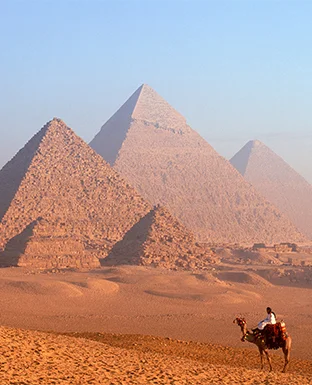The Great Sphinx of Giza, with a lion’s body and a pharaoh’s head, stands as one of Egypt’s most iconic landmarks. Carved from limestone, this colossal statue measures 73 meters in length and 20 meters in height. It guards the Giza Plateau, symbolizing strength and wisdom. The Great Sphinx is considered to be the embodiment of antiquity and mystery.
This article’s main goal is to offer every traveler all the facts and information about the Great Sphinx. This article was written by a team of tour operators, tour guides, knowledgeable historians, and travel consultants who know everything about the Great Sphinx.
It has illuminated the imagination of many poets, travelers, adventurers, and scientists over the millennia, and even today, its origin remains an enigma. Great tales of mystery and wonder have been told about this incredible statue that showcased a whole new aspect of ancient Egyptian mythology, architecture, and artistic expression.
Symbolism and Construction
The Sphinx embodies Ra-Horakhty, a form of the mighty sun god, symbolizing royal strength and protection. This monumental statue, carved from a single block of limestone, has a lion’s body and a human head adorned with a royal headdress, representing both power and wisdom. It measures 73 meters in length (240 feet), 19 meters in width (62 feet), and 20 meters in height (66 feet).
The Necropolis of Ancient Memphis
The Sphinx was part of the necropolis of ancient Memphis, the center of power for the pharaohs. It stands near the three Great Pyramids of Giza: Khufu (Cheops), Khafre (Chephren), and Menkaura (Mycerinus). Between its front paws lies a small temple with inscribed steles dedicated to the sun god Ra. Among these is the Dream Stela, placed by Pharaoh Tuthmosis IV in 1400 BC, commemorating a dream in which the Sphinx spoke to him.
Construction and Purpose
Traditionally, the statue is believed to have been constructed during the 4th dynasty of Egypt’s Old Kingdom, under Pharaoh Khafre’s reign (2558 – 2532 BC). However, this remains a topic of debate. Sphinx statues were considered powerful guardians of cemeteries, explaining their placement in locations such as the Giza Plateau and the Karnak temple complex.
Depictions in the New Kingdom and Beyond
In the 12th dynasty of the New Kingdom, some prominent queens and princesses were depicted as Sphinxes, including Queen Nefertiti and Queen Hatshepsut, whose statues can be found at Karnak and her mortuary temple, respectively. During the Greco-Roman period, Egyptian Sphinxes were transported to Europe, where many still remain today.





Comment (0)